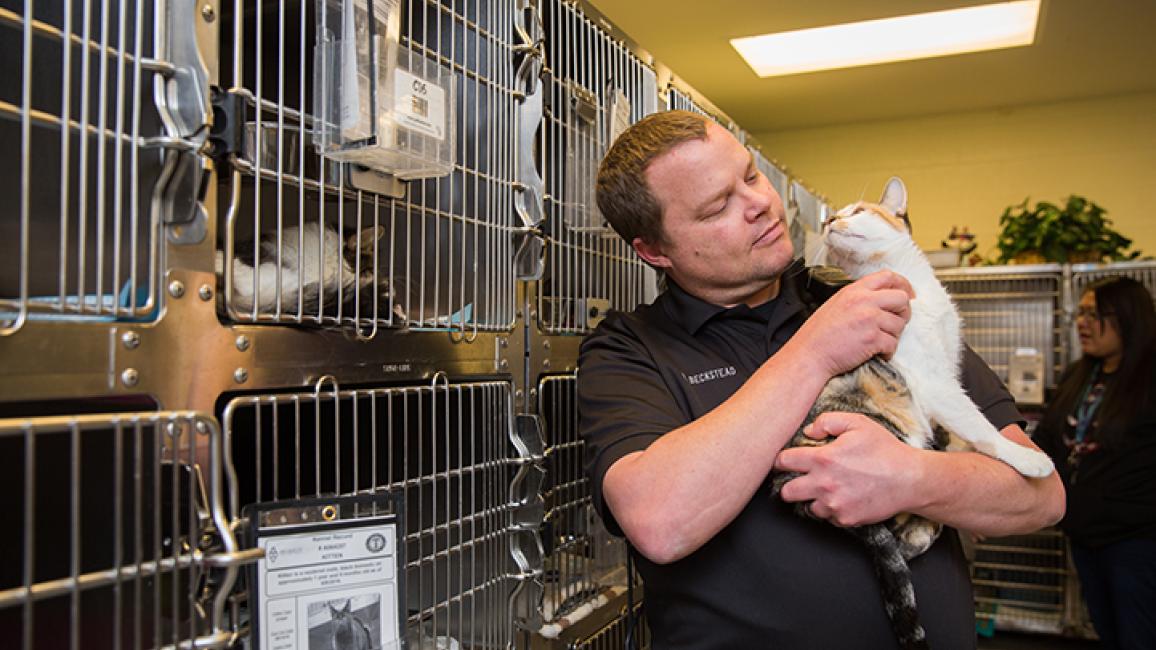Animal control: The no-kill movement’s not-so-secret ally

Virtually every community that has achieved no-kill has done so either through the leadership of the local animal control agency or in close collaboration with them. Animal control is the critical partner of any no-kill coalition.
That is why a bumper sticker that showed up in Rio Rancho, New Mexico, is so disturbing and counterproductive. It reads “Rehabilitate a dog. Euthanize an animal control officer.”
What? When did this type of sentiment become OK? Even in the era of the most contentious debate between old school, catch-and-kill thinking and the vanguard of the no-kill movement, this would not be tolerated, and it shouldn’t be today.
Best Friends categorically condemns this misguided attitude toward animal control — or anyone else for that matter. The operation that put this out is a one-woman show with a small dog-training business and a bad attitude. Mostly what this kind of message does is feed ammunition to the few remaining old-line, holdout agencies and organizations looking for anything to help them discredit the no-kill movement (not that this woman was advocating for no-kill or any coherent policy).
This type of thinking couldn’t be more at odds with Best Friends’ thinking or with the no-kill movement as a whole.
As we stride toward 2025 and the end of the killing of shelter animals in this country, one of the most exciting developments is the speed at which no-kill policies and programs are being taken up by municipal animal control agencies, with animal control officers stepping into the role of advocate and ambassador.
This shouldn’t come as a surprise, since no one wants or should have killing healthy and treatable homeless pets as part of their job description. Sadly, that has been the case in our shelters since their creation almost 150 years ago.
Today, more frequently than not, ACOs are our colleagues and friends — not the enemy. And if saving more lives and achieving no-kill by 2025 is what we all want, our relationship with these essential members of our lifesaving team must be collaborative and supportive — not adversarial.
Empowering these officers to fill that critical lifesaving role is at the nexus of much of Best Friends’ work today. In fact, this year’s Best Friends National Conference in Los Angeles included an entire track devoted to progressive animal control practices featuring such progressive leaders as Ed Jamison from Dallas Animal Services and Lauren Bluestone from Metro Animal Care and Control in Nashville.
Thanks in part to social media pushing accountability and transparency from government officials, police officers, city council members and animal control officers, these groups have become major priorities for communities of all sizes. Residents want to know that their tax dollars are being spent wisely, and on programs aligned with their values.
This includes replacing outdated and ineffective animal control practices with innovative programs that keep people and pets safe, happy and healthy. And a new generation of animal control agencies and officers is stepping up to save lives and meet their communities’ expectations, but they can’t do it alone. And they can’t do it if they’re under attack.
Proactive governance and keeping pets out of shelters
We are a nation of animal lovers and a nation of problem solvers. Where once an animal control officer would be dispatched to trap and collect an animal, after which that animal would often be killed, local animal services are now focused on identifying animal-related problems and implementing long-term, cost-effective solutions.
Similar to the community policing model that champions proactive problem-solving techniques, animal care and control services are now partnering with the public and other agencies to go beyond simply reacting to complaints, and instead using data and planning to implement long-term solutions with preventative measures. Animal control agencies across the country, including those in such cities as El Paso (Texas), Boise (Idaho), Yakima (Washington) and Palm Springs (California), have embraced this proactive approach and recently completed specialized training with Best Friends Animal Society in areas such as conflict resolution and community cat programming.
Keeping pets in homes and out of shelters is at the heart of the animal control officer’s role. By minimizing the number of animals entering shelters in the first place, we can make already scarce resources available to help the animals who really need them.
For example, animal service agencies in Santa Clara, California, and Washington, D.C., have switched to issuing warnings and providing support and cost-effective resources to pet owners with violations, rather than issuing costly citations that often result in an animal unnecessarily entering the shelter.
Animal control officers want lifesaving solutions, too
Around the country, shelters and animal control agencies are looking for solutions designed to save pets’ lives rather than end them. Best Friends has partnered with animal services directors and officers in places like Baltimore, Maryland; Pima County, Arizona; Pitt County, North Carolina; and Riverside, California. These folks are community-minded and looking for community-based lifesaving solutions.
For an accurate picture of animal control today, please check out this video. They are our partners and our colleagues.
Together, we will Save Them All.
